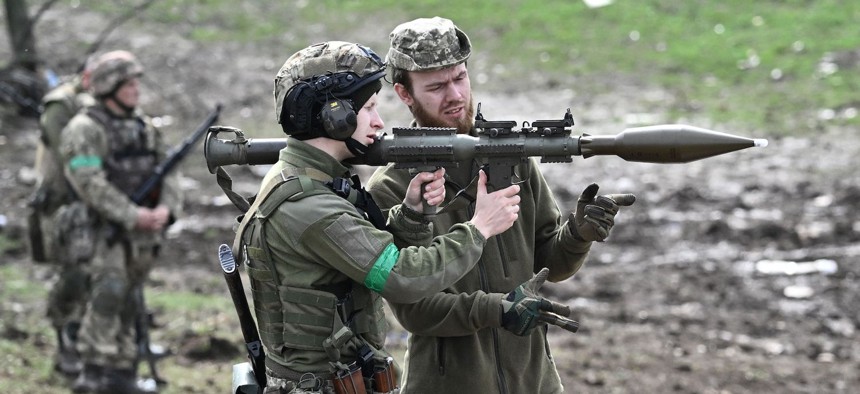SAM SKOVE

Soon after Ukraine blunted Russia’s 2022 invasion, senior U.S. officials attributed some of the defenders' success to the help Americans had provided them before the war’s start.
Training with U.S. troops transformed Ukraine’s Soviet-style military to a more NATO-style force, then-Pentagon press secretary John Kirby said in April 2022.
"They have better command and control," he said. “That didn't happen by accident.”
U.S. and allied training made Ukraine a “more battlefield-effective” force, a senior Defense Department official added.
But experts and one U.S. officer involved in the process say that while the training did help, it isn’t possible to draw a straight line to Ukraine success. Experts in particular pointed to a Ukrainian officer-corps still rife with Soviet-style thinking.
U.S. Army Col. Andrew Clark has commanded the service’s Security Assistance Training Management Organization since August 2021. Among the organization’s responsibilities is teaching other countries U.S. military strategies through its Doctrine Education Advisory Group.
The unit had members stationed in Ukraine before the outbreak of the war and they worked to revise the teaching curriculum at the Ukrainian staff colleges that trained the country’s officers. Their work was akin to a gentle push that gradually improves a partner’s force over time, Clark said. “We build these small custom teams for a long-term engagement,” he said. Some members even lived full-time in Ukraine.
By contrast, the U.S. soldiers training Ukrainian forces in Germany now have no prior training in security assistance.
Clark’s team in particular worked on helping the Ukrainians embrace the decentralized decision-making process that defines U.S. military practice. Under this doctrine, senior officers set a goal and more junior officers use their own initiative to accomplish it, a method that contrasts to the Soviet Union’s more hierarchical approach.
But Clark was cautious about assessing his team’s impact on Ukraine. “I can’t say how well it permeated, " he said, “this was all a work in progress.”
Still, Western military reforms were at least somewhat helpful, particularly as they came alongside significant social change in Ukraine, Will Reno, a professor at Northwestern University, told Defense One in an interview. Ukraine began seeking greater integration with Europe and the United States after Russia annexed Crimea in 2014 and sponsored a proxy war in eastern Ukraine.
However, it’s difficult to link specific foreign efforts prior to 2022 to Ukraine’s military success against Russia, said Jahara Matisek, an associate professor in the Military and Strategic Studies Department at the U.S. Air Force Academy.
U.S. assistance at the time “was very small and pinprick, precisely because the U.S. and NATO were trying so hard to not provoke Russia,” he said.
Matisek recounted seeing little NATO-style training evident during a visit to Ukraine’s Odesa military academy in 2021. There was “no concept” of mission command doctrine, the NATO-style training that emphasizes initiative among lower-ranked officers, he said.
Younger officers he met were different. They had combat experience from fighting in eastern Ukraine, and bought into the U.S. military’s way of waging war.
“It was pretty clear to me that there was a divide” between the young Ukrainian military personnel and the colonels who were 40 years or older, he said.
Reno, the Northwestern professor, recently traveled to southern Ukraine and spoke with two Ukrainian military units—one mechanized infantry unit near Odesa and one of the new battalions Ukraine formed to make up for wartime losses. The tension between younger, more independent-minded officers and more senior Soviet-influenced officers was clear, even after a year of war with Russia. Soldiers complained of Soviet-style leaders who provided inadequate training. In one instance Reno heard about, combat engineers learning de-mining techniques were told to use pot lids as mock mines. They were then told to practice their skills by miming defusing the pot-lids.
The soldiers instead taught themselves how to work as sappers, but couldn’t get certified by the military because the training wasn’t official, he said. Several Ukrainians soldiers Reno spoke with complained that individuals who did complete official courses would be certified, but not actually competent in their assigned specialties.
In the absence of instruction from higher-ups, many younger soldiers are taking matters into their own hands. Reno described lieutenants finding U.S. and Israeli videos on doctrine and translating them into Ukrainian to teach themselves necessary skills.
Ukraine’s high casualties in the war may also have watered down the effect of any Western training provided before Russia’s full-scale invasion of Ukraine began in February 2022. In November of last year, Gen. Mark Milley said Ukraine had probably suffered a similar number of wounded and dead to Russia, which he said had taken more than 100,000 casualties since the start of the war.
“Some units may have had the benefit of us or other Western engagements,” Clark said, “but you may have new, provisional units that had no benefit of us.”
Looking back on the six years his group spent training Ukraine, Clark said he would have wished for 20 years more to train the troops to fight back before Russia’s invasion.
“I would have loved to have many more years,” he said, “If I knew a country was going into war, you want as much time as you can.”
No comments:
Post a Comment